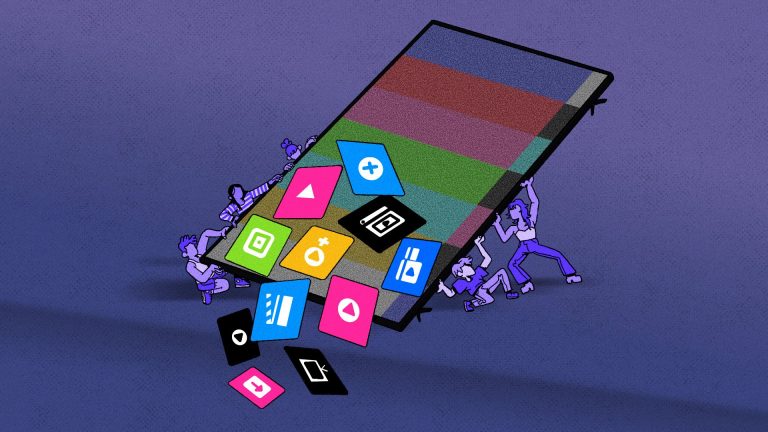
For those of us TV fans who cut the cable cord ages ago, it’s time again to cut… something. I don’t honestly know what we’re cutting this time exactly. But it’s time to cancel all your streaming services. To use the industry term, churn out every month, and don’t churn back in unless a particular service has something you just can’t miss.
That’s right: go cancel them all.
After all, how many of these ever-increasing monthly fees are you already tolerating? The average is reportedly four, and depending on whether or not you pay for the ad-free options, that could set you back about $75 per month. And four services isn’t enough to keep you in the loop about everything buzzy on TV. If you just pay for four of the most popular ones — perhaps Netflix, Max, Amazon Prime, and Disney+ — you missed awards juggernaut Shōgun on Hulu (the ad-free version of which now costs an eye-watering $18.99 per month). And how have you survived 2024 without the Olympics on Peacock? Oh, and you’re on track to miss out on Severance season 2 if you’re not an Apple TV+ subscriber.
The sneaky price spiral just goes on and on until you’re paying more than the cost of cable — and there’s a good chance you are.
Then again, you probably don’t just watch your favorite shows. If you’re like a lot of people, you often fire up a streaming service app, browse to whatever you’ve seen talked about online, and give it a try. And what’s your reward for such open-mindedness? Perhaps you watched streaming services dump some of your favorite characters into festering swamps like they did in Secret Invasion, or Velma. Maybe you tuned into The Circle season 6, which featured the unwatchably try-hard plot twist of an “AI” contestant. Maybe you checked out The Idol, or Deep Fake Love, which you’d heard were so bad they’re good, but they turned out to be so bad that you just want those precious hours of your life back.
Millions of Americans are already quitting in 2024. In response to password-sharing crackdowns, rising costs, and the proliferation of ads on streamers like Netflix, Disney+, and Amazon Prime — which one day decided to turn ads on for you by default — consumers in 2024 are cancelling streaming services in record numbers.
But don’t just make a mental note to cancel when the offerings on one service or another feel exceptionally dire; go cold turkey right now. The best part of streaming à la carte instead of paying all the time is the newfound freedom you’ll feel not to watch the next big thing if you don’t really want to. You’ll soon notice that other, cheaper, better ways of consuming TV and movies have just become strangely attractive.
How streaming arrived at its cut-the-cord moment so fast
Cord cutting the first time around was a no-brainer because it felt like everyone agreed that cable was a drag. Watching TV in the ’90s sometimes meant clicking around the upper channels of your cable package, waiting for something — anything remotely interesting, please — to come back from an epic commercial marathon. It certainly wasn’t what you wanted as a paying consumer, but it was obviously the experience the pay TV industry wanted you to have.
For millions of cord cutters (not to mention “cord nevers“) that experience is gone forever, but the feeling of time and money flushed down the toilet, supposedly in the name of “entertainment,” is back with a vengeance.
A decade ago, it felt like the Silicon Valley disruptors had arrived to fix the entertainment industry. House of Cards showed up on Netflix in 2013 like a precision-guided missile of politically charged melodrama straight to the cerebral cortexes of “discerning” viewers like myself. (It turned out we weren’t all that discerning; we were just TV gluttons at our first all-you-can-eat buffet). Netflix’s addictive grand slam during its first at-bat was astonishing. The networks could never. HBO could sometimes, but who can remember what HBO’s first-ever drama even was? (Answer: Philip Marlowe, Private Eye. Yeah, me neither).
Netflix was defying the very laws of entertainment industry physics. The stream-and-binge TV era had begun, and it felt like nothing would ever be the same. The Big Data guru Rick Smolan told the New York Times’ David Carr in 2013, “Programmers have been wandering out and shooting a shotgun into the night sky and hoping they hit something, and I end up paying $150 for channels full of nothing I want to watch. These guys know what they are aiming at.”
But the TV industry has fully reverted to its old ways in the decade since that House of Cards moment. The business is once again all about getting people to overpay for tons and tons of ad-saturated mediocrity. Dan Goman, CEO of the video software company Ateliere Creative Solutions, told Forbes earlier this year that, “For many years, streaming services offered subscriptions at rates that were enticingly low,” but that, “We’re now seeing the industry gravitating toward familiar models — ads and bundles.”
You already know the highlights here: One after another, streaming services are hiking their prices, in a series of moves designed to push consumers to cheaper ad-supported tiers which generate more revenue than the premium ones. Meanwhile, the services themselves kill programming users expect to be there in an effort to cut their spending on library content, all while degrading cherished brands, abandoning quality in favor of quantity, and — perhaps oddest and most irksome of all — cutting corners on audio, making it hard to literally hear the content we’re paying our hard-earned money for.
The term “enshittification” is overused these days, but this sort of thing is exactly what its coiner, Cory Doctorow, had in mind when he came up with it. As Doctorow wrote last year:
Why is Netflix putting the screws to its customers? It’s part of the enshittification cycle, where platform companies first allocate surpluses to their customers, luring them in and using them as bait for business customers. Once they turn up, the companies reallocate surpluses to businesses, lavishing them with low commissions and lots of revenue opportunities. And once they’re locked in, the company starts to claw back the surpluses for itself.
Do streaming services deserve your passive, monthly dollars?
Regardless of how you feel about the overall degradation of the streaming experience, maybe you just like knowing the content you love is available anytime you want, and that makes keeping your subscriptions worthwhile. But time and again, you’ve opened up a streaming service hoping to see something you could have sworn was there, and it was just… gone. It’s not your imagination. On top of everything else, Streamland has become a messy place where it’s never clear how to find what you want, and what you can count on today might be gone tomorrow.
Think the trashy reality show that binds your friend group together will always have a home on Peacock? Think your Disney+ subscription is a parenting must-have because it houses the whole Disney and Marvel animated universes? Think the long-awaited streaming service Venu (assuming it’s ever allowed to exist) has the makings of the mythical stable home for sports programming that all sports fans have been dreaming of?
Think again. Fire up any given streaming service, and what you’ll see is the confusing result of behind the scenes wheeling-and-dealing, with no apparent thought given to reliability or viewer convenience.
As an illustration of this convenience problem, look at Sex and the City. The intuitive place to watch all things Sex and the City is Max, the service formerly known as HBO Max, but Sex and the City’s availability on Max may well be in danger. Yes, SATC is safe on Max for now, but starting this past April, it became available on Netflix too. A bit confusing, but as soon as the dollars and cents penciled out, Max’s parent company gave up exclusivity and let Netflix in on the action. If you can keep track of all this in your head, no big deal, but it gets worse: you’d better believe that one day soon, Max may very well stop streaming Sex and the City. If that sounds implausible, it shouldn’t. You already can’t watch the movie Sex and the City 2 on Max.
Max, like all streaming services, will unceremoniously dump its most treasured content if it feels like it. I cannot watch my personal favorite COVID-era movie, An American Pickle, on Max — nor on literally any streaming service whatsoever — even though it was an HBO Max exclusive when it debuted. And remember HBO’s hit show Westworld? You already can’t watch it at all on Max even though it bagged Emmys and was by some measures HBO’s biggest hit of all time. Want to stream Westworld on a monthly service? As far as I can tell, there is one streaming service with exclusive streaming rights to Westworld: DIRECTTV’s “Premier” streaming package, which will set you back — are you sitting down? — $149.99 per month.
This brand of chaos is the most reliable attribute in the streaming universe. Not even bundling Hulu and Disney+ together guarantees access to all things Marvel. To wit: Marvel’s Runaways, a Hulu original is now exclusive to Apple TV+. The Office — a longtime NBC hit which achieved cultural critical mass only when it became a Netflix staple, is no longer on Netflix. For that you have to go to Peacock, the NBCUniversal streaming service, which is making itself a major destination by becoming the only place to stream the likes of Yellowstone, the biggest hit on the Paramount Network, but which doesn’t stream on Paramount+. So you might assume you need the all-powerful Peacock for that other NBC mega-hit, Friends, right? Not so much. Friends is only available on… Netflix? Nope, for heaven only knows what reason (money), Friends is only available on Max. Netflix is no longer your destination for legendary NBC shows. Oh, except Seinfeld. For the next two years. And after that who knows?
The promise of streaming in the first place was instant gratification, and subscribing to upwards of eight streaming services doesn’t guarantee any gratification at all. What’s a content addict to do?
Watch whatever you want. You’re free.
After you cancel them all, you’ll find that in a manner of speaking, you have more access to the programming you want, not less.
In the barbaric bygone days of content consumption, everyone tolerated something called “video rental.” Before Netflix came along and started mailing people discs in paper sleeves (yes, that was once the entire Netflix business model), this way of consuming movies and TV involved the very real hassle of physically getting off your duff and going to a store. It also meant an even worse hassle that seems totally alien now: late fees. But in terms of content-for-money, this terrible system was vastly superior to what we have today. The viewing possibilities felt truly limitless. If your local chain video store didn’t have what you were looking for, you could hunt for it elsewhere in town, or — if it was really obscure — fork over the extra money and buy it, even if that meant importing a disc from another country.
That feeling of boundless possibility is partly why some people — mostly nostalgic film buffs — are still video store partisans. But you don’t have to take on any such affectation to get the benefits of the pre-streaming lifestyle (and none of the drawbacks) thanks to this one weird trick: just watch TV and movies à la carte. À la carte video rental is admittedly a form of streaming, but without the subscription. And it couldn’t be easier to get started: You can just Google the exact movie or TV show you want to watch, find a site that lets you rent or “buy” that piece of content for viewing on your preferred device or smart TV, and enjoy your truly personalized entertainment experience.
Forking over these small amounts can feel like a splurge or even a defeat if you already pay the standard American $75 per month to access “unlimited” streaming content on a bunch of streaming services, but if you cut ties with those monthly fees, you’ll instantly have a nice à la carte budget. Most movies will set you back somewhere between $2 and $5 (fresh-from-theaters new releases like Blink Twice can set you back $19.99, but that sort of extravagance isn’t really part of the à la carte equation), and watching a single TV show episode can look like a $0.99 rental or a rather steep $2.99 “purchase” with no option to rent.
And à la carte is, in fact, essentially the only way to watch some of those favorites I mentioned earlier, like Westworld and An American Pickle. The freedom of being a streaming service cord cutter, then, means you’re in a charmed position in which you can just not sweat the shrinking archives at the streaming services at all.
Not relying on streaming services changes how you watch, but only a little
Canceling your streaming services and getting yourself used to à la carte streaming are just two steps on the path to maximizing your entertainment dollar. While you’re at it, an antenna and a blu-ray/DVD player are good investments that will pay for themselves in a hurry. What’s more, your local library has discs you can bring home for free, and if you’re honest with yourself, you probably have some movies and box sets collecting dust around the house that you could watch instead of chasing a new shiny object on one of the streamers.
Now that you’re free, you can make a bucket list of every movie and TV show you’ve ever hoped to watch, and just work your way through it.
As for me, I’ve started thinking about TV somewhat differently, but I don’t feel nearly as cut off as one might think. I subscribed to Max recently so I could watch Curb Your Enthusiasm‘s final season, and while I had that subscription, I scratched a couple movies from the Max archive off my watchlist before canceling. When White Lotus season 3 comes out, this cycle will begin again.
Sports were a problem when I had streaming services, and it’s certainly still a problem now that I don’t, but I have an antenna for in-market games, and I watch baseball in bars — where other fans are — instead of at home.
But the best way to summarize my new TV outlook is my attitude toward the Star Wars franchise. I’ve completely avoided all the Star Wars shows, and I have no regrets, but I’m considering watching Andor. I might, and I might not. As a streaming cord cutter, I still enjoy taking risks on new streaming shows from time to time like White Lotus and The Curse, but I mostly prefer bucket list classics, or shows where I’m more or less guaranteed to get what I want, like Law & Order: Organized Crime (available for free with my trusty antenna). In short, I rarely involve myself in shows with those deliciously intriguing opening episodes, which might turn out to be genius, but let’s face it, usually turn out to be the TV equivalent of low-effort clickbait.
So if the second and final season of Andor jumps the shark, I’ll have dodged a bullet. If it gets the same rapturous response as the first season, then I’ll know it’s a good bet. I’ll subscribe to ad-free Disney+ for exactly one month, and I’ll watch the whole thing at my own pace.

















0 Comments